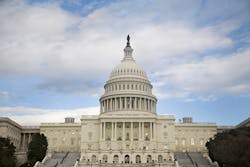House Passes Coronavirus Response Act
The MCAA has released a summary of the contents and status of the Families First Coronavirus Response Act (HR6201). The House passed the legislation on Saturday March 14th, with technical amendments added on March 16th. The measure calls for paid sick and family leave for employees in three different provisions.
1. Emergency Paid Leave Benefits: Requires all employers with one or more employee to provide "public health emergency leave" to all eligible employees, who have been employed for 30 or more days. Covered absences include time off for any qualifying need related to a public health emergency-any emergency with respect to the coronavirus declared by a Federal, State, or local authority covering the workplace (including the commuting route), employee residence and/or community. Covered leave includes:
- Employee's diagnosis of COVID-19, and either self-imposed or directed quarantine because of coronavirus exposure;
- Family member diagnosis of COVID-19, and either self-imposed or directed quarantine because of a family members' exposure to coronavirus; and
- Childcare or family member care responsibilities due to school or daycare facility closure (Definitions of family members are in line with those broadly defined and set out in the Family and Medical Leave Act).
The employee is entitled to two-thirds of their average monthly earnings, not to exceed $4,000 for each 30-day period (offset all amounts of other paid leave for the same absence). Employers may apply for reimbursement by the Social Security Administration for covered leave, offset by any other payments for the time off.
(NOTE: In a late change in the legislative corrections process, this Family and Medical Leave coverage may have been limited to only paid time to care for children whose school or daycare is closed because of the emergency.)
2. Paid Sick Days for Public Health Emergencies and Personal/Family Care - Accrued Sick Leave: Requires employers engaged in commerce and employing one more individuals, to provide employees accrued paid sick leave at a rate of one hour for every 30 hours worked, up to a maximum of 56 hours per year. The accrual begins at the outset of employment, and the employee is entitled to use the leave beginning on the 60th day of employment, and may thereafter be used as it accrues.
Accrued sick leave may be taken for absences due to employee illness, injury of healthcare diagnosis, public health emergency workplace closure, or quarantine because of communicable disease, and for absences to care for a child, parent, spouse, domestic partner or other individual related by blood or affinity with the employee for absences due to similar causes. Also, covered absences include those due to domestic assault, abuse, stalking, legal proceedings, medical and counseling care relating to those same causes.
3. Additional Paid Sick Leave due to a Declared Public Health Emergency: Each employer in the jurisdiction with a declared public health emergency shall provide pay for 14 days of continuous absence for salaried employees, and regularly scheduled pay for part-time and hourly employees to cover a continuous 14-day period (10 work days). Employees are entitled to paid leave on the first day of employment. Employees can use both the additional sick leave and any accrued sick leave at the outset of the public health emergency. Covered absences include those stated for accrued sick leave above.
Employers with fewer that 50 employees may be reimbursed by the Treasury Department for those amounts of paid emergency leave upon application and attestation to the Labor Department.
With respect to both the paid sick days and personal family care - accrued leave and additional leave, the House measure contemplates collective bargaining and benefit fund administration in multiemployer bargaining units, and employer payment into jointly administered funds and employee payment of benefits from those funds. The measure would go into effect upon enactment and expire on December 31, 2020, as currently written, with some reservation about public emergency declarations extending beyond the end of 2020.
Status of Legislation:
As of March 17th the Senate has not taken up the House-passed measure, and there remains considerable controversy and dispute concerning the breadth and scope of the various overlapping paid leave provisions. MCAA and the Construction Employers Alliance are analyzing the various provisions and will be commenting to lawmakers as they move forward. One item of most concern is the new accrued paid leave provision which has less of an emergency relief character than the public health emergency measures.
The paid leave provisions are subject to Administration changes in the Senate; however, some have said the Senate may defer to the final House passed measure. That legislative prediction could change as Congress delays the return to DSC and the emergency measures stack up in the process. Some have mentioned the prospect of an omnibus economic stimulus measure in the near term. This digest merely provides an outline of what is on the table before Congress as of March 16th.
